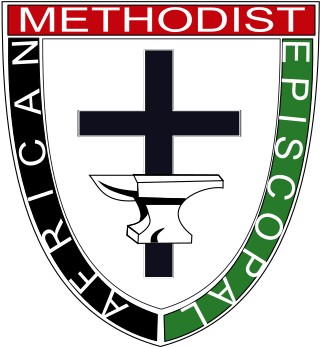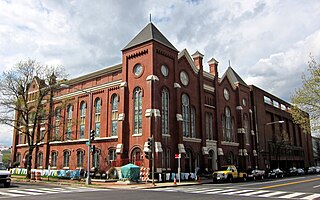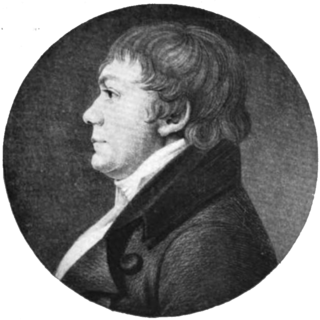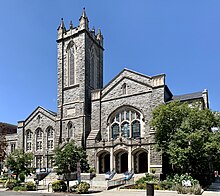The United Methodist Church (UMC) is a worldwide mainline Protestant denomination based in the United States, and a major part of Methodism. In the 19th century, its main predecessor, the Methodist Episcopal Church, was a leader in evangelicalism. The present denomination was founded in 1968 in Dallas, Texas, by union of the Methodist Church and the Evangelical United Brethren Church. The UMC traces its roots back to the revival movement of John and Charles Wesley in England, as well as the Great Awakening in the United States. As such, the church's theological orientation is decidedly Wesleyan. It embraces liturgical worship, holiness, and evangelical elements.

Francis Asbury was one of the first two bishops of the Methodist Episcopal Church in the United States. During his 45 years in the colonies and the newly independent United States, he devoted his life to ministry, traveling on horseback and by carriage thousands of miles to those living on the frontier.

The African Methodist Episcopal Church, usually called the AME Church or AME, is a predominantly African American Methodist denomination. It adheres to Wesleyan-Arminian theology and has a connexional polity. The African Methodist Episcopal Church is the first independent Protestant denomination to be founded by black people; though it welcomes and has members of all ethnicities.

16th Street Northwest is a prominent north–south thoroughfare in the northwest quadrant of Washington, D.C. Part of Pierre L'Enfant's design for the city, 16th Street begins just north of the White House across Lafayette Park at H Street and continues due north in a straight line passing K Street, Scott Circle, Meridian Hill Park, Rock Creek Park, and the Walter Reed Army Medical Center before crossing Eastern Avenue into Silver Spring, Maryland, where it ends at Georgia Avenue. From K Street to the District line, 16th Street is part of the National Highway System. The Maryland portion of the street is designated Maryland State Highway 390. The entire street is 6.4 miles (10.3 km) long.
Edwin Holt Hughes was an American bishop of the Methodist Episcopal Church, elected in 1908.
Boston University School of Theology (STH) is the oldest theological seminary of American Methodism and the founding school of Boston University, the largest private research university in New England. It is one of thirteen theological schools maintained by the United Methodist Church. BUSTH is a member of the Boston Theological Institute consortium.
Titus Lowe was an English-American Bishop of the Methodist Episcopal Church and The Methodist Church, elected in 1924.

Frederick Lewis Swann was an American church and concert organist, choral conductor, composer, and president of the American Guild of Organists. His extensive discography includes both solo organ works and choral ensembles he has conducted.
J. Philip Wogaman is former Senior Minister at Foundry United Methodist Church in Washington, D.C. (1992–2002), and former Professor of Christian Ethics at Wesley Theological Seminary Washington, D.C. (1966–92), serving as dean of that institution from 1972–83.

Towson United Methodist Church is a large United Methodist Church in the historic Hampton subdivision of Towson, a suburb in Baltimore County, Maryland. Its past, rooted in 19th-century America and subsequent growth in the two centuries since then, has closely paralleled the nation's political and sociological trends. It was a congregation split asunder in 1861 on the eve of the American Civil War in a border state of divided loyalties, which eventually reunited and built a church in the post–World War II era of the 1950s, a time of reconciliation and rapid growth by mainline Protestant denominations, especially in the more affluent suburbs.

The National Presbyterian Church is a Christian congregation of approximately 1,500 members of all ages from the greater metropolitan Washington, D.C., area. The mission statement of the church is "Leading People to Become Faithful Followers of Jesus Christ Together in God’s World"
University United Methodist Church, Austin, Texas, is a United Methodist Church belonging to the Rio Texas Conference of the United Methodist Church. Located at the corner of 24th Street and Guadalupe Street, UUMC has been a fixture near the University of Texas at Austin campus for more than 120 years.

Shiloh Baptist Church is a Baptist church located in Washington, D.C.. 20001 in the historic Shaw District. The church was founded in Fredericksburg, VA in 1804.

Frederick Brown Harris, a Methodist clergyman has the distinction of the longest service record as Chaplain of the Senate, in a term of service interrupted by the chaplaincy of Peter Marshall.

The Washington Street United Methodist Church is a historic church at 1401 Washington Street in Columbia, South Carolina.

Broad Street United Methodist Church is a historic Methodist church located at 155 Central Ave NW in Cleveland, Tennessee, United States.

Plaque Commemorating First Formal Religious Service , is a public artwork by American artist Howard Petty, located on the Indiana Statehouse, in Indianapolis. It was created in 1923 and set in the statehouse in 1924. It commemorates the first religious services held in Indianapolis in 1819 and the first organized church in 1821. The plaque is made of bronze and depicts a walnut tree in the foreground with a log cabin in the background. It is approximately 22 inches (560 mm) wide by 35.5 inches (900 mm) high and has a depth of .75 inches (19 mm).
Cynthia Fierro Harvey is an American bishop in the United Methodist Church and president of its Council of Bishops. She is the first Hispanic woman to lead the Council of Bishops. Harvey is the Resident Bishop of the Louisiana area, and oversees the Louisiana Annual Conference.

Bishop Singleton T. Jones was a religious leader in the African Methodist Episcopal Zion Church. When he was ten years old, he was apprenticed to a lawyer and worked for him for four years, after which he found positions at an inn, as a hod carrier, and on a riverboat on the Ohio River. He became a pastor in the 1840s, serving churches throughout Pennsylvania, New Jersey, Maryland, and the District of Columbia. Although he had little education, the taught himself to be an articulate orator. Besides being a pastor to churches, he also edited AME Zion publications, the Zion's Standard and Weekly Review and the Discipline.

Henry Foxall was an English-born American politician, industrialist and Methodist preacher. He is considered the first United States defense contractor because he supplied the U.S. Navy during the Quasi War, First Barbary War and the War of 1812 with cannons and cannonballs from his iron foundries in Philadelphia, Georgetown and Richmond, Virginia. He also served as Mayor of Georgetown and helped found the Foundry United Methodist Church in Washington, D.C.
















